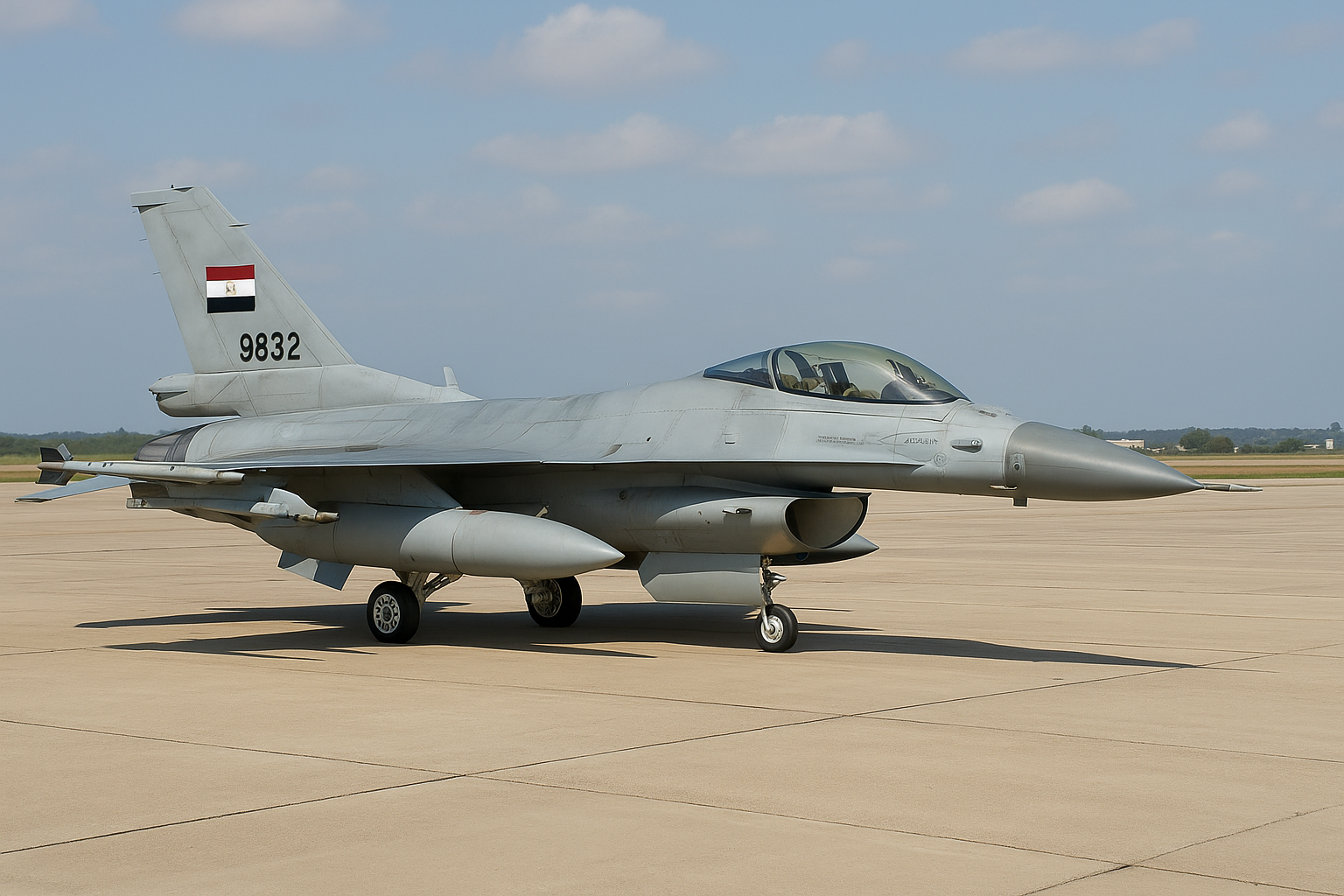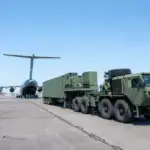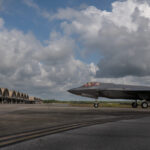FORT WORTH, Texas – The U.S. government has released an initial $213 million so Lockheed Martin can begin long-lead work on 20 Advanced Block 52 F-16s for the Egyptian Air Force. A Letter of Offer and Acceptance under the Foreign Military Sales program covers the first engineering and parts orders and sets the production line in motion. This mirrors similar procurement efforts abroad, such as the competition between F-16V vs. Gripen in Slovakia.
John Larson, vice-president for F-16 programs, welcomed the award. He called Egypt “a trusted repeat customer committed to a balanced air fleet,” and noted that the buy brings global Falcon orders past 4,400 aircraft for 25 nations.
Egypt F-16 Deal Expands Arab World’s Largest Falcon Fleet
- Total value of first increment: $213 million
- Total aircraft: 16 F-16C single-seat and 4 F-16D twin-seat jets
- Configuration: Block 52 with Pratt & Whitney F100-PW-229 engines, AN/APG-68(V)9 radar, modular mission computer, color multifunction displays, Link 16 capability, and night-vision compatible cockpit lighting
- Planned final delivery: 2013
- Program code name: Peace Vector VII
Egypt opened the Peace Vector series in 1980 when it received 42 Block 15 F-16s. Additional lots arrived through the 1990s, giving Cairo the largest Falcon fleet in the Arab world. By 2009 the inventory reached 220 aircraft drawn from six separate contracts. Peace Vector VII adds an all-digital subset optimized for precision weapons and beyond-visual-range missiles, though specific weapon clearances remain subject to U.S. export rules.
The Egyptian Air Force (EAF) plans to base the new fighters at Gebel el-Basur and Cairo West. Officials say the two-seat F-16Ds will boost instructor throughput and enable complex strike training without foreign advisers in the back seat. Deliveries will overlap with a new F-16 simulators complex funded under a separate $45 million infrastructure package decided last December. The training center includes dome visual displays, mission rehearsal tools, and secure data links that mirror the live aircraft systems.
Operational commanders see the Block 52 purchase as insurance against regional air-power shifts. In briefings to parliament last month, Air Marshal Reda Mahmoud indicated that the fighters will anchor quick-reaction alert missions on both the Mediterranean and Red Sea coasts. C-model Falcons will carry a standard loadout of two AIM-9M Sidewinders, two AIM-7M Sparrows, a centerline fuel tank, and a LANTIRN targeting pod until Egypt clears AIM-120 beyond-visual-range missiles.
U.S. oversight remains tight. A joint production and quality-assurance board meets quarterly in Fort Worth. Egyptian engineers attend final-assembly inspections and paint-shop roll-outs. The first airframe is scheduled to leave Station 6 by late 2011, with Block acceptance tests at Edwards Air Force Base before ferry to Cairo.
The contract also funnels steady work into the Texas production line. Lockheed Martin expects to retain about 250 direct jobs and sustain hundreds more in the supply chain across 40 states. Larson said that lower-rate orders keep critical skills alive while the company markets the F-16 to new customers that cannot yet step up to the F-35.
Regional analysts view the order through a strategic lens. Iran continues to refurbish its 1970s-vintage F-14s, and Syria is courting MiG-29SMT upgrades from Russia. By adding radar and weapons commonality across its existing F-16 fleet, Egypt signals that it will keep pace without leaping into fifth-generation costs. Defense economist Byron Callan estimates Cairo will spend another $700 million on follow-on support, engines, and munitions once the long-lead phase transitions to full-rate production.
Lockheed Martin’s Fort Worth site will fabricate forward fuselages and wings, while final mating, systems checkout, and flight-line acceptance remain under the same flow that turns out U.S. Air Force airplanes. BAE Systems supplies the digital flight-control computer, Raytheon provides electronic-warfare receivers, and Northrop Grumman delivers the AN/APG-68(V)9 multimode radar. U.S. government officials stress that the Egyptian configuration does not include the full electronic countermeasures options sold to NATO users.
Egyptian F-16 Configuration Prioritizes Combat Capability Over ECM Suite
Egyptian crews will enter the U.S. Air Education and Training Command syllabus at Tucson, Arizona, in mid-2011. A cadre of 20 pilots and 50 technicians is already lined up. The syllabus includes high-angle-of-attack recovery, precision ordnance delivery, and tactical datalink operations. Upon graduation, a mobile instructor team will accompany the first jets home for six months of frontline conversion to specific desert procedures.
Lockheed Martin’s industrial-participation promises extend beyond aircraft. Egyptian officials secured agreements for future avionics repair in country and technology transfer for composite-airframe maintenance. Wichita-based Spirit AeroSystems will share best practices on wing repair, while Pratt & Whitney will train depot mechanics on digital engine-health monitoring. These offsets dovetail with Cairo’s aim to expand its domestic aerospace footprint.
Congress approved the initial obligation after the State Department signaled that the sale supports regional stability. A similar focus on alliance capability was seen in the Dutch order for additional F-35s to strengthen NATO airpower. The Defense Security Cooperation Agency emphasized Egypt’s long record of safeguarding U.S. technology. The program remains subject to end-use monitoring, but no special restrictions were added beyond standard FMS compliance.
Delivery of the first jets will coincide with an overhaul of Egypt’s early-warning network. Upgraded AN/FPS-117 radars, acquired through a separate contract, will feed more accurate tracks into the EAF’s command-and-control system, extending intercept coverage deeper into the Gulf of Suez and over the Sinai.
Analysts warn that financing constraints could stretch the delivery schedule. Egypt relies on annually appropriated Foreign Military Financing credits, and any broad reduction in U.S. aid would force Cairo to renegotiate payment milestones. For now, Lockheed Martin officials say the funding stream looks solid.
FA-50 Deal and F-16 Replacement Moves – March 2025 Update
Fifteen years passed. Every jet ordered under Peace Vector VII now flies from Egyptian ramps. The first eight Block 52s crossed the Atlantic in July 2013, touching down at Cairo West after tanker stops in Lajes and Souda Bay. The final four airframes arrived in November 2015, after Washington lifted the arms freeze imposed during the political unrest of 2013. With those deliveries complete, Egypt’s Falcon inventory stands at 240 aircraft across seven versions.
Operational tempo rarely slackened. EAF Falcons patrolled Sinai airspace during counter-insurgency sweeps and flew deterrence sorties near Libya. In November 2024, Exercise Phoenix Armor brought U.S. Air Forces Central Command and Egyptian pilots together for live dropping on El Nafaq range. Block 52 crews demonstrated laser-guided GBU-12 attacks from 20,000 feet while Link 16 data links fused feeds from American E-3G radar pictures. The event capped two years of bilateral sorties that sharpen tactics against mobile air-defense units.
Egyptian F-16s Sustain Regional Posture Amid Modernization Demands
Maintenance, not combat, proved the bigger challenge. By 2020, mean-time-between-failure rates on key avionics doubled because Egypt struggled to source spares under tightened U.S. export rules. A December 2024 BAE Systems contract aimed to reverse the trend by repairing F-16 avionics-test-station modules for 11 foreign users, Egypt among them. Earlier, a July 2024 Northrop Grumman award set aside $50 million for radar repair, giving Cairo a reliable pipeline for AN/APG-68(V)9 transmitter modules.
The readiness gap pushed Cairo to diversify suppliers. In early 2024, plans to replace F-16s with Chinese jets surfaced as Egypt reportedly inked a preliminary deal for 24 Chinese J-10C fighters. Beijing later denied a finalized sale, yet rumors persisted because Egyptian delegations toured Chinese production plants twice in 2023. Analysts in Cairo’s Al-Ahram Center link the flirtation with long-running frustration over restricted U.S. weapons packages – especially AIM-120 missiles that never cleared Congress.
F-16 Replacement Options Drive Egypt Toward China and South Korea
In parallel, Cairo pivoted to South Korea. On April 22, 2025, the Egyptian Armament Authority and Korea Aerospace Industries signed a framework to import 36 FA-50s, with an option to license-build up to 70 more at Helwan. The Cairo–Seoul FA-50 agreement marked a key milestone in Egypt’s shift toward Asian defense partnerships. The deal, reportedly worth $1 billion for the first tranche, packages instructor support and engine-test-cell upgrades. Air Marshal Mahmoud called the light fighter “a twin benefit – fresh airframes for advanced training and leverage to extract better terms on future F-16 upgrades.”
Washington has taken notice. A March 2024 contract placed with Lockheed Martin extended Falcon sustainment coverage through February 2025. The U.S. Air Force now supplies engineering reach-back, configuration-management audits, and software patching tools to keep Egypt’s F-16s in line with current structural-integrity bulletins. Without that support, Cairo would face grounded jets as center-barrel life expires in 2027.
Cairo also invested at home. American International Contractors finished a hardened hangar complex at Gebel el-Basur in late 2023. Reinforced walls and blast doors allow weapons-loaded jets to shelter from drone swarms, a threat proven in conflicts across the Middle East. The same package delivered spare-parts storage and an expanded avionics bench, halving turnaround time for radar-receiver repairs.
Policy winds still blow cool at times. U.S. officials quietly paused approval for AIM-9X missiles after a 2022 Congressional review over human-rights concerns. Egypt operates older AIM-9Ms and local supply is dwindling. Air planners must decide whether to rely on French MICA missiles carried by Rafales or pursue license-built short-range weapons with new partners. The gap limits Falcon effectiveness against advanced drones and stand-off cruise missiles flowing into the region.
Despite friction, the Block 52s keep their value. The airframes logged fewer than 3,500 flight hours each, well under the 8,000-hour design life. Structural audits in January 2025 found no bulkhead cracking thanks to smoother runway surfaces laid during a U.S.-funded infrastructure push in 2018. The EAF intends to fly these jets to at least 2040, provided engine overhaul slots remain open in Pratt & Whitney’s Midwest depot.
Looking forward, Egypt faces three forks. Option one: accept U.S. limits, double down on Falcon upkeep, and press for incremental weapon clearances. Option two: split its fleet, using new Chinese or Korean jets for high-end roles while relegating F-16s to homeland defense. Option three: pursue a broad, indigenous upgrade program similar to Turkey’s Özgür initiative, swapping mission computers and radars without Washington’s blessing. Each path carries cost, schedule, and diplomatic trade-offs.
For now, Peace Vector VII stands as the last wholly U.S.-financed fighter project in Egypt. The 2010 contract delivered exactly what it promised – 20 pristine Block 52 jets that still roar above the Nile valley. Yet the strategic landscape evolved. Cairo’s search for autonomy drives fresh alliances, and the Falcons’ future depends on how well partners adapt to that new map.
REFERENCE SOURCES
- https://www.aeronewsjournal.com/2025/04/cairo-and-seoul-sign-agreement-for.html
- https://news.lockheedmartin.com/2010-03-03-Lockheed-Martin-Receives-213-Million-Contract-for-20-New-F-16s-for-Egypt
- https://www.f-16.net/f-16-news-article4009.html
- https://www.f-16.net/f-16-news-article4972.html
- https://www.defensenews.com/air/2015/11/06/egypt-takes-delivery-of-final-4-delayed-f-16s/
- https://www.dvidshub.net/image/8777524/exercise-phoenix-armor-f-16-arrival
- https://www.defense.gov/News/Contracts/Contract/Article/3986721/
- https://www.defense.gov/News/Contracts/Contract/Article/3855763/
- https://english.defensearabia.com/an-evolving-strategic-landscape-egypts-shifting-military-partnerships/
- https://defence-blog.com/egypt-to-replace-f-16s-with-chinas-fighter-jets/
- https://www.f-16.net/f-16_users_article4.html
- https://thechinaacademy.org/egypt-swaps-u-s-f-16-for-chinas-j-10c-fighter-jets/
- https://thedefensepost.com/2024/09/10/egypt-orders-j10c-jets/



